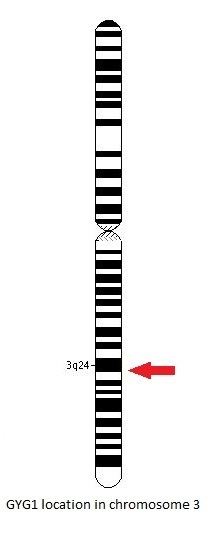Entrez 2992 | Ensembl ENSG00000163754 | |
 | ||
Aliases GYG1, GSD15, GYG, glycogenin 1 External IDs MGI: 1351614 HomoloGene: 31219 GeneCards: GYG1 | ||
Glycogenin-1 is an enzyme that is involved in the biosynthesis of glycogen. This enzyme is important for the function of self-glucosylated to form an oligosaccharide primer that serves as substrate for glycogen synthase. This is done through an inter-subunit mechanism. It also plays a role in glycogen metabolism regulation and in the maximal glycogen levels attaintment in skeletal muscle. Recombinant human glycogenin-1 was expressed in E. coli and purified by using conventional chromatography techniques.
Contents
Glycogen metabolism
Glycogen is a multi branched polysaccharide. It is the way all the animal cells have to store glucose. In the human body, the two main tissues of glycogen accumulation are liver and skeletal muscle. The concentration of this polysaccharide is superior at the liver, but, due to the major mass of skeletal that muscle humans have, this tissue contains three quarters of the corporal glycogen.
Location of glycogen
On the one hand, the function of the liver glycogen is to maintain glucose homeostasis as a way to compensate the decrease of glucose levels that is given between meals. Thanks to the presence of the glucose-6-phosphatase enzyme (G6PC), the hepatocytes are capable to turn G6PC to glucose and release it to blood so as to prevent the hypoglycemia. On the other hand, in the skeletal muscle, glycogen is used as an energy source to perform muscular contraction during exercise. The different functions of glycogen in muscles or liver make the regulation mechanisms of its metabolism differ in each tissue. These mechanisms are based mainly in the differences on structure and on the regulations of the enzymes that catalyze the way for its synthesis, glycogen synthase (GS), and for its degradation, glycogen phosphorylase (GF).
Glycogen synthesis
Glycogenin is the initiator of the glycogen biosynthesis. This protein is a glycosyl transferase that have the ability of autoglycosilation using UDP-glucose, which helps in the growth of itself until forming an oligosaccharide made by 8 glucoses. Glycogenin is an oligomer, and it's capable to interact with several proteins. In recent years, a family of proteins has been identified, the GNIPs (glycogenin-interacting protein), that interacts with glycogenin stimulating its autoglycolsilation activity.
Glycogenin-1
In humans, two isoforms of glycogenin can be expressed: glycogenin-1, with a molecular weight of 37 kDa and codified by GYG1 gen, which is expressed mostly in muscles; and glycogenin-2, with a molecular weight of 66 kDa and codified by GYG2 gen, which is expressed mainly in liver, cardiac muscle and other types of tissue, but not in skeletal muscle. Glycogenin-1 was described analyzing the glycogen of skeletal muscle. It was determinate that this molecule was united by a covalent bond to each mature molecule of muscular glycogen.
Structure
The glycogenin-1 gene, which spans over 13kb, consists of seven exons and six introns. Its proximal promoter contains a TATA box, a cyclic AMP responsive element, and two putative Sp1 binding sites in a CpG island, a DNA region with a high frequency of CpG sites. There are also nine E-boxes that bind the basic helix-loop-helix of muscle-specific transcription factors.
Location and transcription
The GYG1 gene is located on the long arm of the chromosome 3, between positions 24 and 25, from base pair 148,709,194 to base pair 148,745,455.
Transcription of human glycogenin-1 is mainly initiated at 80bp and 86bp upstream the translator’s codon beginning. Transcriptions factors have different binding sites for its development, some examples are: GATA, activator protein 1 and 2 (AP-1 and AP-2), and numerous potential Octamer-1 binding sites.
Mutation
Deficiency of glycogenin-1 is detected in the sequence of the glycogenin-1 gene, GYG1, which revealed a non-sense mutation in one allele and a missense mutation, Thr83Met, in the other. The missense mutation resulted in inactivation of the autoglycosylation of glycogenin-1, which is necessary for the priming of glycogen synthesis in muscle. Autoglycosylation of glycogenin-1 occurs at Tyr195 by a gluose-1-O-tyrosine linkage. An induced missense mutation of this residue results in inactivated autoglycosylation. However, missense mutation affecting some other residues of glycogenin-1 has also been shown to eliminate autoglycosilation.
Consequences
The phenotypic features of the skeletal muscle in a patient with this disorder are muscle glycogen depletion, mitochondrial proliferation, and a marked predominance of slow-twich, oxidative muscle fibres. The mutations in the glycogenin-1 gene GYG1 are also a cause of cardiomyopathy and arrhythmia.
